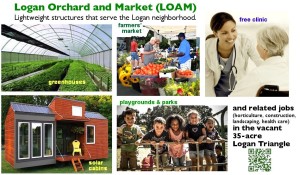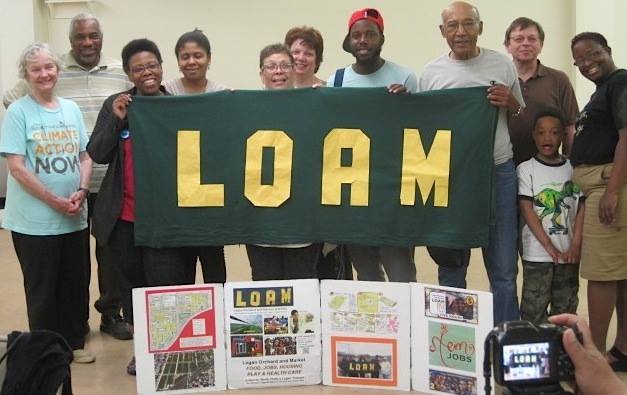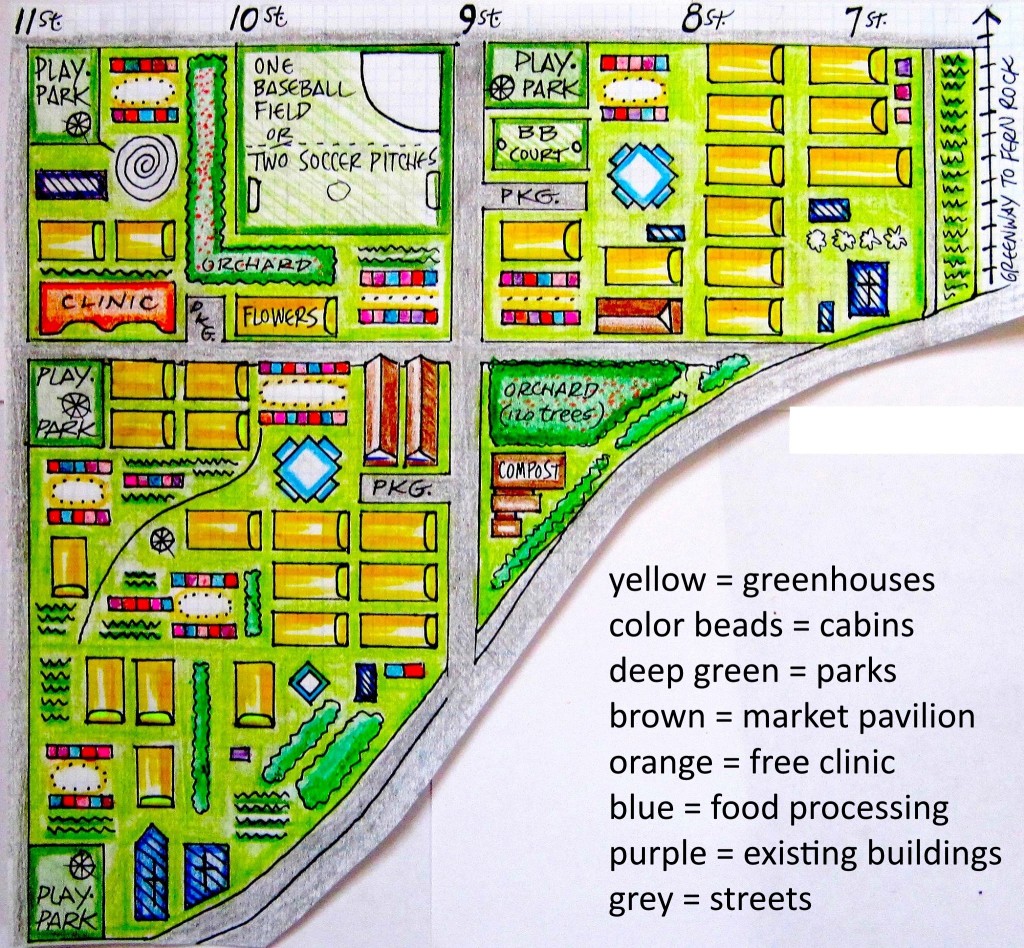FOR IMMEDIATE RELEASE 6/22/15
Logan Orchard and Market LOAM
proposes Green Community for North Philadelphia
The Logan Triangle is North Philadelphia’s notorious 35-acre vacant space, where 997 homes were torn down 20 years ago. Built on loose coal ash 40 feet deep, the homes tilted and cracked.
Therefore, the Logan Orchard and Market (LOAM) proposes to create a major green city model, while meeting basic needs of Logan neighbors for fresh food, affordable housing, health care, work and fun. To do these, LOAM would fill the land with light weight structures suited for this land, featuring 100 greenhouses and 300 solar cabins (aka elder cottages or “tiny houses”) for veterans, returning citizens, young families, professionals. Other key components will include orchards, parks, playgrounds, market pavilions for local food and crafts, and the Patch Adams free clinic. LOAM would likewise be a regional nursery for edible perennials.
 Because the unemployment rate among Logan neighborhood males is 50%, LOAM will offer priority job training horticulture, landscaping, orchardry, floriculture, solar construction, and so forth. Priority housing would become available to Logan veterans, returning citizens, young families, seniors, teachers and artists who’d help manage the land.LOAM advocates met on June 11 with the Philadelphia Redevelopment Authority, which took the Logan acres by eminent domain in 2012. LOAM asked PRA for permission to use one of the 1,000 lots for a pocket park, to bring neighbors together to discuss their preferences. PRA said no, stating that they are negotiating with a developer.
Because the unemployment rate among Logan neighborhood males is 50%, LOAM will offer priority job training horticulture, landscaping, orchardry, floriculture, solar construction, and so forth. Priority housing would become available to Logan veterans, returning citizens, young families, seniors, teachers and artists who’d help manage the land.LOAM advocates met on June 11 with the Philadelphia Redevelopment Authority, which took the Logan acres by eminent domain in 2012. LOAM asked PRA for permission to use one of the 1,000 lots for a pocket park, to bring neighbors together to discuss their preferences. PRA said no, stating that they are negotiating with a developer.
According to Charlene Samuels, co-president of Logan EPIC Stakeholders, “The Logan neighborhood can’t wait another 20 years for a developer to build ‘mixed housing’ on the land. If it were easy they’d have built it years ago. Time to let that dog die and do something innovative. The LOAM proposal can start right away. It provides us fresh food, low cost senior housing, health care, and a great way to connect our children to nature.”
Ernie Bristow, who lives the Logan neighborhood, says “No more talking– talk is cheap! We need to move forward with the LOAM project for the betterment of the community as a whole.”
Katrice Cheaton, a community advocate from the area, declares “LOAM has the potential to empower Logan residents with the tools and resources they need to improve their quality of life as well as help the environment. It’s a win-win model.”
LOAM intends to begin by installing a pocket park, and expand from there. Across Loudon Street from the Triangle lives Ralph Brogdon, who says “There are thousands of young men roaming around here with nothing to do. This will start to repair the neighborhood.” His son Ralph Brogdon Jr. is a government worker and permaculture/agriculturalist. “Learning green skills not only in agriculture/aquaculture/high tunnels, but as a technical aspect such as solar and wind generation will add much-needed job skills for the neighborhood and the Philadelphia area.”
 According to Paul Glover, who drafted the LOAM proposal, “We’ll start small and grow like a coral reef of beauty and plenty. As we proceed we’ll attract grants, volunteers, in-kind donations, and even print our own credits.” Glover is founder of Ithaca HOURS, a large community currency, founder of the Philadelphia Orchard Project, and a dozen other organizations.
According to Paul Glover, who drafted the LOAM proposal, “We’ll start small and grow like a coral reef of beauty and plenty. As we proceed we’ll attract grants, volunteers, in-kind donations, and even print our own credits.” Glover is founder of Ithaca HOURS, a large community currency, founder of the Philadelphia Orchard Project, and a dozen other organizations.
Mary Seton Corboy, founder of Greensgrow Market, on a former brownfield, looks forward to collaborating to revive this land. “We hope this project, like Greensgrow’s work in Kensington, can help revive a blight on our whole City. The scope is large but the problem is large. Logan neighbors are bringing growing ideas where there has only been sinking homes.”
Rachael Griffith, landscape architect with the Land Health Institute, is an advisor to the design team. “Implementing a project such as LOAM could be just what this community and the city has been waiting for. It will reactivate an area which has been blighted for decades in a unique and productive way that will provide greatly-needed jobs and community services and attract agro-tourism, without triggering gentrification. “The city doesn’t need another discount superstore– it needs to support iconic, innovative land uses that will build social infrastructure, benefit the local economy, and rehabilitate our environment. It would be hard to find a use for this tract of land that would satisfy these criteria better than the LOAM initiative.”
LOAM’s lead partners are Choates General Contracting, a member of the US Green Building Council, and A.T. Russell Construction, a Women- and Minority-Owned Enterprise (whose founder also established Logan Enterprises). They will operate within LOAM’s community benefit agreement and design guidelines.
Archye Leacock is founder and executive director of Institute for the Development of African-American Youth (IDAAY) in Philadelphia. He says, “I’m truly excited that LOAM is taking on such an ambitious project of bringing real jobs to the numerous unemployed young people in the Logan neighborhood. IDAAY and I stand prepared to join this team and contribute how and wherever we can to this success.”
LOAM allies will meet on July 13 at Friends Center, 1501 Cherry Street, at 7:00pm to further shape and advance the plans. Our host is the Center for Returning Citizens. Refreshments will be served.
For more information: metroeco@gmail.com 215 805-8330 Facebook * Web * flyers
The Logan Triangle is along Roosevelt Boulevard, between 7th and 11th Streets.
Neighbors and allies growing daily. Click to see community benefit agreement.
#

